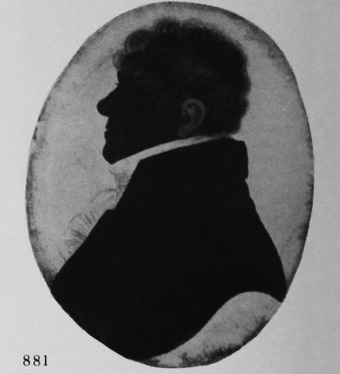Manners, W. H. (McKechnie Section 2)
Recorded by Jackson (The History of Silhouettes), who adds in her Dictionary that Manners exhibited a miniature painting, Portrait of a Gentleman, at the Royal Academy in 1830. He sent it in from 286 High Holborn, London. Foskett tells us that another miniature, painted c. 1827-28, was signed ‘W. H. Manners, Junr. 286, High Holborn, 3 doors from Gt. Turnstile’. The word ‘Junr’ implies that a relative (probably the artist's father) was still living. Jackson records a painted silhouette of Sir Thomas Swinnerton Dyer, R.N. Another example (c. 1830) illustrated in her Dictionary is reproduced here.
Although, since the publication of Jackson's Dictionary, other writers have illustrated silhouettes which they have ascribed to this artist, apparently none of these were signed by Manners or labelled as his work, and therefore the example illustrated by Jackson is the only one which I feel justified in illustrating myself. This profile (of a man) was apparently painted in tones of dark grey, gum arabic being used to show the shape of the coat. The cravat and shirt-frill were painted in thinned pigment (without the use of Chinese white), and the hair probably in gold. The most notable feature of this profile (one which distinguishes it from the work of such artists as Barnes) is the painting of the ear, which was carefully painted, apparently with thinned pigment. The card (possibly rectangular) on which the profile was painted appears to have been trimmed near the front, possibly to fit a papier mâché frame. The bust-line seems previously to have been finished with a pronounced convexity-concavity curve.
The inscription below the silhouette illustrated by Jackson suggests that Manners used a label reading:
W. H. MANNERS
Miniature Studio
286, High Holborn,
London.
Ill. 881

Unknown man
Silhouette painted on card in shades of dark grey, with detail in gold
c. 1830
3 5/8 x 2¾in./93 x 70mm.
? Trade label (stencil)
From E. Nevill Jackson, ‘Silhouette, Notes and Dictionary’ (1938), by courtesy of Macmillan and Co. Ltd
